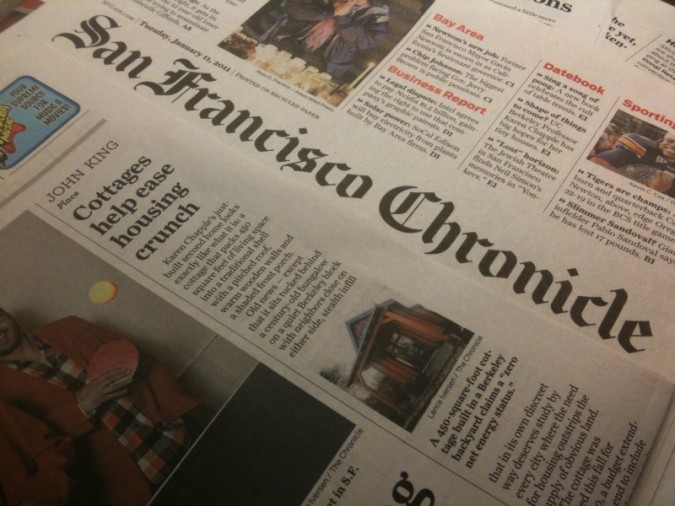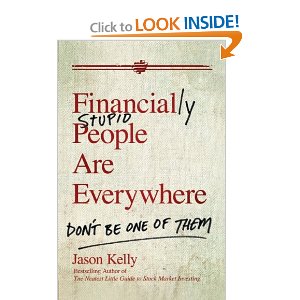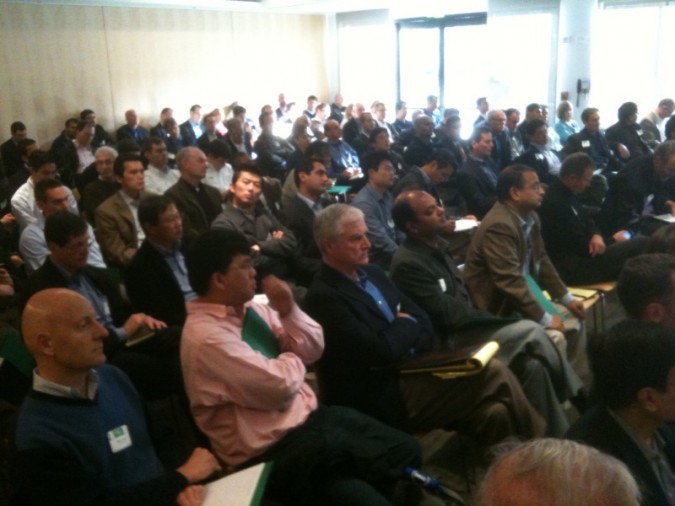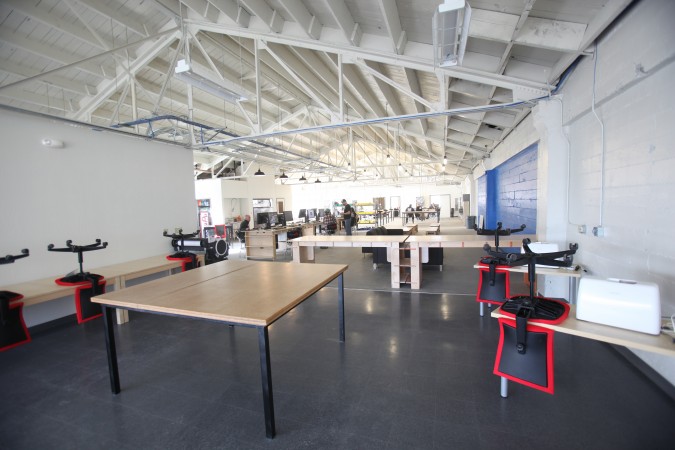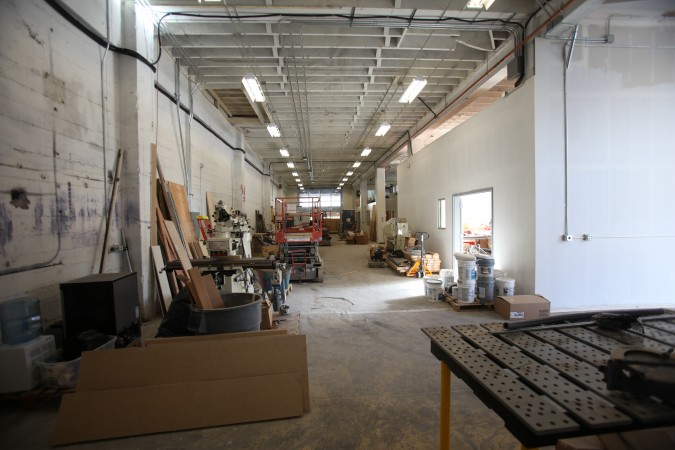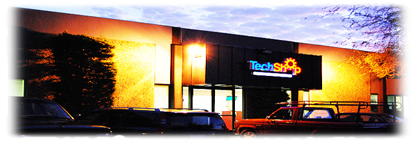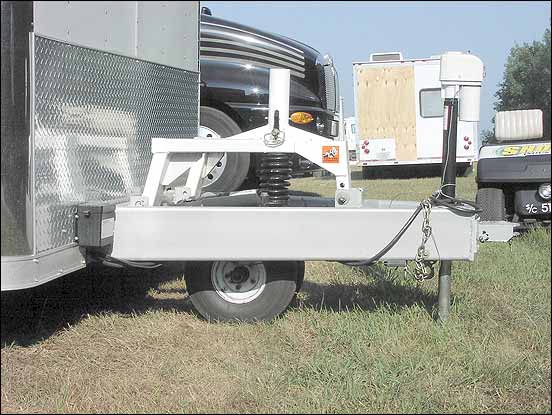Archive for the ‘Work’ Category
New Avenue, Inc. featured in today’s San Francisco Chronicle newspaper
My friend Kevin Casey’s New Avenue, Inc. house that I’ve been writing about here was written about in today’s San Francisco Chronicle newspaper. This is the primary newspaper for San Francisco.
The story appears in the print edition and on the front page of the online edition in a story entitled Berkeley zero net energy cottage deserves study. Since the front page changes all the time, I made a screen capture SFGate_front_page_january_11_2011 so you may see the prominent coverage New Avenue received. I also made a screen capture of the article itself since the Chronicle may take down the article after some time, but I expect this blog will remain accessible indefinitely. Here’s the link to a PDF copy of the full article: SFGate Jan 11 2011 New Avenue article. Note that these PDFs have clickable links, so if you see something you like, you can click it and the link will take you to the same place the SFGate.com version will take you to.
Congratulations to Kevin and New Avenue!
New Avenue, Inc. Ribbon Cutting Ceremony For First Completed Project in Berkeley, California USA
Yesterday I attended the ribbon cutting ceremony for the first completed home built by New Avenue, Inc., which was founded by my friend Kevin Casey.
I estimate 200 people came by to see the 420 square foot backyard detached house. Kevin persuaded the mayors of Berkeley and El Cerrito to speak at the ribbon cutting. I introduced myself to both mayors after the conclusion of the formal event, and they were both very personable and warm.
I shot a lot of pictures and video, but I’ve not had time to edit it. So today I will just post the video of the formal spoken remarks. Later this week I will post the walkthrough video I shot, which is fascinating because you see all the attendees clamoring to examine every corner of this really charming house.
I spoke with many of the people in attendance, including a woman who lived recently in Hawaii in a house this size. She’s a graduate student at UC Berkeley now, and her enthusiasm for what New Avenue is trying to do was contagious.
Tim Ferriss interview at Commonwealth Club of California January 6, 2011
I joined the Commonwealth Club of California on January 6, 2011. Hours after I joined, I was at their Market Street, San Francisco headquarters watching Tim Ferriss be interviewed by a reporter for Bloomberg BusinessWeek magazine. Ferriss is the author of the best selling book The 4-Hour Workweek, which I read last year on the advice of my friend Gleb Budman. I have dismissed books of this genre in the past, but I don’t dismiss this book. There is a lot of wisdom in this book, and I came away from watching the interview thinking even more favorably of Ferriss. Yes, he is an outstanding self-promoter who’s even been voted the most effective self-promoter in the world. Yes, he has done some questionable things I don’t approve of. But he makes a strong case that there is a valid path to success that does not require working round the clock. As far as I can tell, Ferriss works far more than 4 hours per week, and I take the title of his book as being more provocative than literal.
The Commonwealth Club is a public affairs forum, and all speakers volunteer their time to talk at the forum. Thus Ferriss was not paid, although he probably commands a hefty speaking fee in other contexts. Perhaps as a result of the Commonwealth Club’s public mission, there were no requests to shut off cameras or recording devices. In fact, the moderator gave explicit instructions on how to Tweet most effectively about the event so the messages would be discoverable by the Club. As a result of the above, I shot video of the interview with my handheld camera, and part 1 of 3 appears above in this post. The quality is marginal because I can’t hold a camera steady, but the audio is good, and you can still see the action up close despite my less than good camera work. I am not intending to take away from income due Ferriss by posting this here, and if asked by the Club or Ferris or his representatives, I will remove this video immediately. I think that on balance, I help Ferriss by spreading the word to my readership about his work, and it’s in the spirit of helping Ferriss that I post this video here today. I will post parts 2 and 3 over the next week.
Tim Ferriss talks about his latest book, The 4-Hour Body, in this interview. I have not read that book, but I plan to. I flipped through it in the lobby, and it looks worth reading. It’s a large book, probably twice the size of The 4-Hour Workweek. Ferriss is both an entrepreneur and a health advocate, and his passion for both rings true. I got to meet Ferriss at the reception that followed the interview, and he sure makes a great effort to be personable and helpful. He had a swarm of people around him for well over an hour, and I got to meet him toward the end of that time. He was still cheerful and helpful even after what must have been an exhausting several hours for him.
My impression of the Commonwealth Club is great so far, and I look forward to seeing Michael Milken speak later this month.
Kevin Casey’s New Avenue Homes Ribbon Cutting Ceremony January 8, 2011
One of the advantages to my sponsoring the Business Plan Competition at University of California at Berkeley is that I get to meet interesting, bright, motivated students. How does this work exactly? I’m a judge for the competition, and that puts me into regular contact with the student organizers. In about 2007, Kevin Casey was one of the organizers, and we got to know each other just a little bit. But I remembered him, and when he got into the tiny house movement, I took notice and contacted him.
He’s taking a different approach than I plan with my Green Homes venture I haven’t started but probably will at some point. But his approach is valid and he’s making solid progress.
Kevin Casey’s company is New Avenue, Inc. Here’s their mission statement, which I copied directly from their website for precision:
“In the United States 40 million of the 70 million single family homes have just one or two people living in them. These under-used homes were designed for easy building, not quality living, and they drive a seemingly endless list of negative effects such as sprawl, traffic congestion, lifelong “homeowner” debt, and costly energy use. This incredible waste of space is the result of the traditional model of accommodating growth through suburban tract home development. The US Census projects a need for 12.5 million additional homes by 2020 and we need a new way of creating these homes.
New Avenue is an alternative development model that enables communities to grow internally as opposed to externally. We do this by building homes on underutilized properties within existing neighborhoods. Our homes are designed to accommodate the true diversity of our family types, namely those of us that live in one or two person households. We call this the small plot development model and it can end suburban sprawl as we know it, accommodate the demand for 12.5 million new homes we need and bring financial and environmental sustainability to families.
New Avenue delivers a turnkey solution for building these one and two person homes. We have unique expertise in design, land use rights, financing, permitting and pre-fab manufacturing that allows us to create building opportunities where it is either illegal or unprofitable for the old fashioned banks, builders and developers to operate.
By creating new legal and financial products we eliminate the barriers that foil the old way of building and enable the creation of tens of thousands of right-sized homes that are energy efficient, attractive and healthy to live in. The homes we build provide financial security to landowners and strengthen our communities without consuming any additional green space.
The installation of small second homes can create community, enhance health, produce renewable energy, and provide a financially sustainable alternative for property owners and investors to shape the future of our communities.”
Kevin’s New Avenue has built its first home, close by in Berkeley, California. It’s in the back yard of a detached house that belongs to a UC Berkeley professor. I’ve toured Kevin’s tiny house twice, once while about half done and once after it was completed. It’s a charming, warm and livable home. It’s a mere 420 square feet, but I think a single person could comfortably live in it for years. The only thing it really needs that it doesn’t have is a washer and dryer.
Kevin arranged for no less than the mayor of Berkeley to be on hand for the ribbon cutting ceremony, which is scheduled for tomorrow, Saturday, January 8, 2011 at 2:30pm. The preliminary festivities start earlier at 1pm. I plan to attend, and if you’re in the area, I encourage you to attend as well. Kevin has BIG plans for New Avenue, and I wish him the best of success in his ambitious entrepreneurial adventure.
My friend Sara Olsen likes what Kevin’s doing as well. Here’s an article she wrote for GreenBiz.com entitled The Social ROI Green, Affordable Housing. She writes that Kevin plans to build a stunning 10,000 tiny houses in the next few years. Kevin shared that detail with me as well, but I didn’t know if it was a number intended to be publicized. Since Sara published it, I’ll emphasize her point here. Kevin certainly thinks big. Maybe I’ll one day be talking about shipping 10,000 shipping container Green Homes… I hope so.
Please fill in your email address in the upper right corner of this page if you’d like to subscribe to this blog. I’m trying to build my subscriber base, which is why I’m cluttering up some of these posts with this request. If you like my writing, please also leave me a comment and tell your friends about this blog. Thank you!
Financially Stupid People Are Everywhere – Don’t Be One Of Them
Yesterday was New Years Eve – a fitting time to finish reading a good book by Jason Kelly – Financially Stupid People Are Everywhere, Don’t Be One Of Them. This book hammers home the notion that most people are stupid about money and need to radically change their view towards it and approach to getting and making most valuable use of it. I have made plenty of mistakes with money, for which I am embarrassed and not proud. Had I read and followed the advice in this book when I sold Hotpaper.com, Inc. and made a substantial pot of money, I might now have several times that pot of money. Instead I have less than all of it remaining, which Kelly would frown on I’m sure.
Jason Kelly uses blunt, provocative language to make his points. It’s unlike any financial book I’ve yet read. The message of the book is that the system is designed from every angle to quickly and completely separate people from their money, and that one must forever change behavior if one is to avoid having their money drained.
There is no particular great wisdom in this book, but even so it’s a good book and worth reading. In particular, people with lots of debt, little savings and little hope should run to the library and check out this book and read it in a day or two. It’s a quick read, and hard to put down. I have already adopted many of the suggestions in the book like paying cash for my vehicles and not carrying any balance on credit cards. But I still have a long way to go before Jason would give me a clean financial bill of health.
It’s the first day of 2001 today, so it seemed fitting to write about a book that has more potential to unshackle millions from their debt induced indentured servitude than any other single book I’ve read. Highly recommended.
2011 Cleantech Opportunities and Outlook: The Investors’ Perspective
The law firm Orrick LLP puts on an outstanding free event series it calls Total Access. The events are organized by Chad Lynch, Orrick’s Director of Corporate Business Development. I met Chad around six years ago when I was working really hard on my startup gOffice.com, then the world’s only true online office suite. I haven’t seen Chad in years, but I reintroduced myself today, and he remembered meeting me and remembered the year. He knows thousands of people I’m certain, so he sure has a good memory for faces.
Chad Lynch used to have the comparable job at the law firm Pillsbury Wintrop, an Orrick competitor. That’s when I met him. I’ve stayed in touch via his emails, and today I went to my first Total Access event in years. They begin at 7:15am in Menlo Park, California, and I live in San Francisco, so I have to wake up really early to get down there on time, particularly since the direct route is Highway 101, which is particularly congested during rush hour compared to the other major North/South route, Interstate 280.
I’m glad I braved the traffic this morning, as the event was worth my while. The subect matter was ‘Cleantech Opportunities and Outlook: The Investors’ Perspective.’ There was a panel of four venture capitalists, including one I know from my days raising venture capital for my first Internet startup Hotpaper.com, which I later sold at a profit to Purple Communications (then GoAmerica, Inc. – NASDAQ GOAM).
The panel answered about three dozen questions over an hour. The consensus is that Cleantech is now past its baby steps, but still a toddler. The group was upbeat about the prospects for starting and funding cleantech companies in 2011. Interestingly, the panel did not see any new solar panel companies getting funded unless the panel efficiency is to be over 20% and the cost per watt is to be under a dollar! These requirements represent a very high bar, from the little I know about that industry. I sure wouldn’t want to be trying to get a solar panel company funded today.
What made the event so worthwhile is I gave my elevator pitch for the ‘green homes’ idea I’m kicking around in my head as a possible venture to work on. The VC panelist I know actually seemed interested and asked me to email him an executive summary. I wasn’t even planning on telling him about green homes, but he saw my new green homes business card and asked me about it, even though there was a line of people twenty minutes deep waiting to shake his hand. We had a nice chat about it, and he was familiar with California AB1866, the law that gives ‘green homes’ potential legs to stand on.
As soon as I finished talking with this VC, a cleantech attorney pitched his boutique cleantech law firm to me, and said he had experience with land use issues I would be sure to encounter. While I’m very loyal to Eric Jensen, my corporate attorney since the mid 1990s, I might schedule a lunch with this guy to hear what he has to say, since I don’t think Eric knows much about land use issues and real estate in general. Eric’s an amazing attorney though, and for high tech ventures it’s unlikely you could do better. I’ve known Eric since 1989 when he was a brand new associate at Cooley LLP. Now he heads their business department.
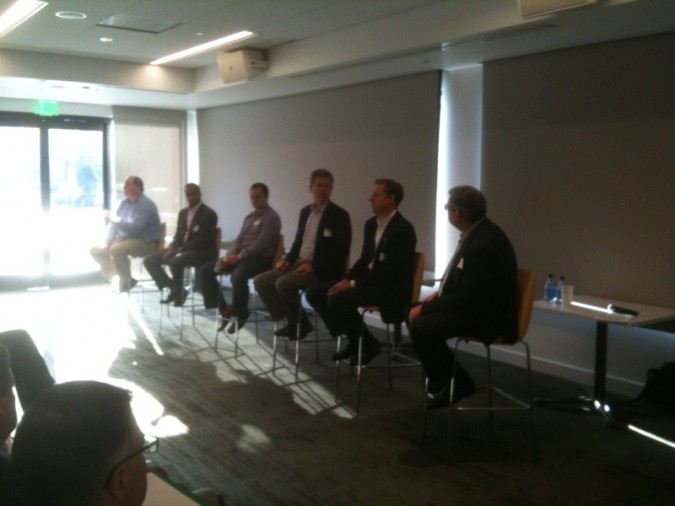
Orrick Cleantech Panel Dec 16, 2010 Menlo Park, California. Left to right: Erik Strasser, Ravi Viswanathan, Warren Hogarth, Don Wood, Jeffrey Adams, Mitch Zuklie
As you can see from the above Apple iPhone 3GS photos (sorry for the low quality) I took at the event, there is a lot of interest in Cleantech. There were people standing in the aisle to my left out of camera view. Remember, this was early in the morning, so I found the turnout to be amazing. Chad told the audience that Orrick has signed up 90 new clients from these events, which, again, are free to attend, and all you need is an invitation which you can get by signing up online at Orrick’s website.
The panelists were from well known and well respected firms. Erik Strasser is General Partner at Mohr Davidaw Ventures. Ravi Viswanathan is General Partner at New Enterprise Associates. Warren Hogarth is Partner at Sequoia Capital. Don Wood is Managing Director at Draper Fisher Jurvetson. Jeffrey Adams is Managing Director at Goldman Sachs. The moderator was Mitch Zuklie, Partner at Orrick LLP. I introduced myself to all the panelists except Mitch, who ducked out before I had a chance to say hello.
Note that while Orrick is staging these events to market themselves, they soft pedal that aspect, and I think only about 60 seconds of the event was spent on asking for business.
The subject matter covered by these events is broad, and it’s certainly much broader than cleantech. I recommend Total Access events without reservation.
I saw a classic LinoType machine
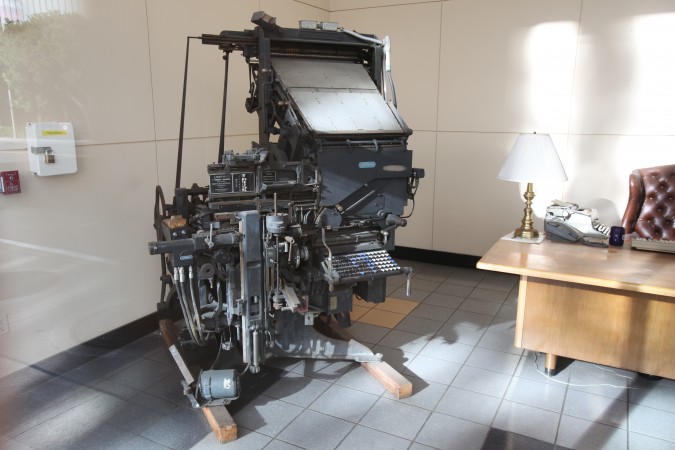
Old LinoType typesetter, in the lobby of the San Francisco Chronicle newspaper, 5th Street, San Francisco, California, December 6, 2010
When I was a student in 6th grade at Laboratory Schools in Chicago, we went on a field trip to a printing company. One of the machine operators there made each student a lead impression of their full name using a machine similar to the one pictured above. I don’t think these are used anymore because of the lead fumes, and because a computer can do a much better job, generally. I am particularly fond of this LinoType typesetter since I have devoted a fair part of my life to electronic typesetting, through my work with TeX, LaTeX and ConTeXT at my startup gOffice.com. I saw this machine December 6, 2010 in the lobby of the San Francisco Chronicle newspaper on 5th Street in San Francisco.
Kevin Warnock’s patent
I invent lots of things.
One of the things I’m most proud of is online document creation. I started this work in 2002, founded the first true online office suite company, Silveroffice, Inc., in 2003, and launched the first true online office suite in 2004. The suite continues operating to this day, although it’s not ‘a success’ like I hoped for when I began. But I continue to have high hopes for the site, and I still devote energy to it. I haven’t done much with the site for years now, but just recently I’ve started working on it again, in the last few weeks. Great things are happening again.
I own a patent for online typesetting, and I thought my readers might like to actually read the patent, so I’ve loaded it on my blog here: US20040073708. While this appears to be just an application, the patent has been issued.
I’m at TechShop San Francisco on its opening day
I’m writing this from the brand new branch of the do-it-yourself TechShop membership workshop. It opened less than two hours ago. There are people here working. Someone is already cutting what appear to be Christmas tree decorations on the laser cutter. There are people working on the powerful Hewlett Packard workstations. Only the top floor is open to members, and only part of the upstairs is really complete. But still, TechShop is open, and it’s really cool. The location is great – Howard Street at 5th Street. The building has high ceilings. It does look like it could be freezing here in the winter, as I don’t see any evidence of heat. That plagued NoiseBridge last winter. I suspect TechShop will install heaters since they sure appear to be well funded. All the equipment here is brand new. The Ikea couch I am sitting on right now is brand new. Yes, that’s a new floor standing Jet mill in the front left of the picture below on the first floor. I’ve always wanted one of those for my garage!
TechShop in Menlo Park, California
I am writing this post from TechShop in Menlo Park, California. TechShop is a membership do it yourself shop. They have a wide array of tools so costly and large one could not own them and keep them at home, unless one had a really large house and was prepared to devote most of it to a workshop.
I am really excited right now, as TechShop will soon open a branch location in San Francisco, just a block from the Moscone Center convention center. This location is easy to get to from my house as the Muni Metro stops at Montgomery Street, just a few blocks from the new TechShop.
I joined TechShop today as a full member of the as yet unopened San Francisco branch. One of the perks is that one can use the Menlo Park shop free of charge until the San Francisco branch opens, which could happen any week now. It’s supposed to open this month, but apparently the more realistic opening time is next month.
I got a thorough and exhaustive tour of the Menlo Park TechShop from a very enthusiastic employee named Mel. I told him about my desire to one day build extremely green homes from ocean shipping containers, and he got it immediately. He advised getting started as soon as possible as he said the media will love this idea, and there is an upcoming TV show to be shot at TechShop next year that would probably like to cover a project like this provided it’s beyond the idea phase.
I’ve been thinking about Green Homes, my code name for the project, particularly feverishly this month. Many of the intriguing ideas I’ve worked up in my head for my bus conversion apply to shipping container based green housing as well. I really want to help make the world a better place, and I’ve become a huge fan of the movement away from so-called McMansions towards more realistic sized homes.
I’ve struggled with how I would promote such a business and make sales. I have decided that among the best ways to spread the word would be to make a prototype home and take it on tour, the way Jay Shafer of Tumbleweed Houses does with his small conventionally constructed houses. Shipping containers are heavy, so I can’t tow one with my car. But, thankfully, I have a bus conversion that can tow a large trailer. I checked today and it appears there are hitch mounting points in place, as I saw connection points to let the vehicle be towed from the back. These anchor points are massive.
A shipping container home will be heavy, as a 20 foot container empty weighs nearly 5,000 pounds. By the time I add granite counters and tile floors the weight could be up around 10,000 pounds. Even for a bus conversion this is heavy, but there’s a cool product that I read about first just last evening. It’s called Tuff Tow. Tuff Tow is a pair of wheels you install into the trailer up front by the hitch. These wheels are freeway capable, and are on a swivel mount. These wheels can support up to 2,000 pounds. The idea is that the large majority of the tongue weight of the trailer is offloaded onto the Tuff Tow device, and only a few hundred pounds is placed on the actual vehicle hitch. This means my bus conversion would only have to deal with pulling the container, and not with potentially huge vertical axis forces, which would be especially high going over bumps and dips in the road at speed. The Tuff Tow costs $1,700 but it will make towing a heavy green home painless for the tow vehicle, and it will mean I can detach the home from the tow vehicle without jacks, I believe.
I can envision myself driving around North America showing a self contained green home, giving speeches, participating in panel discussions, educating politicians, inspiring students and generally being an advocate for more efficient living. I think I would be a good television guest, and that I could direct my sales skills towards persuading people to change their aspirations for an ever larger home. While a bus conversion might seem to be a counter productive tow vehicle due its huge size, my conversion gets 11 miles per gallon as it’s a 4 cylinder, not an 6 or 8 cylinder like most bus conversions. A bus is long and heavy, which makes for safer towing of a heavy trailer. But the real benefit to using the conversion is that I can avoid the heavy footprint and cost of staying in a hotel while on tour, as I can stay up front in the conversion. If I tried to stay in hotels with a shipping container home hitched to a 15 mpg pickup truck, I don’t know where I would park the combo, as I doubt many hotels would want me to take up five parking places to rent one room. The bus conversion is also a great demonstration of small and efficient living, so visitors would be able to see two compact homes at once, which I think increases the public relations value of any tour.
While I don’t yet know if it’s possible, my current plan is to weld trailer axles directly to the shipping containers, fabricate the A shaped hitch, install a Tuff Tow unit up front and tow the container without attaching it to a trailer, as the container would itself be a very durable self contained trailer. I’ve not seen such a trailer before, so this might well be one of the key early inventions of mine in my quest to become a green home entrepreneurial leader.
From what I’ve seen and picked up from the several hours I’ve now been at TechShop, I am hopeful that by my membership here that I will be able to make quick progress towards making my first green home, using many of the amazing tools and resources they have here.
